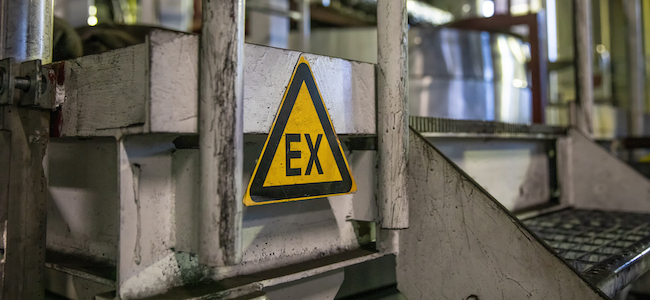ATEX Zones and Categories

The term ATEX originates from the French 'atmosphère explosible'. Classification of hazardous areas (ATEX zoning) and associated equipment selection is summarised below3,4,14. Normal operation indicates where installations are used according to their design parameters3.
Gas, Vapour and Mist
The following table shows each Ex Zone where there is a presence of an explosive atmosphere consisting of dangerous gas, vapour and mist mixed with air, for varying amounts of time. These are defined in 1999/92/EC Annex I3.
| Ex Zone | Explosive Atmosphere |
|---|---|
| 0 | Continuously present or for long periods or frequently |
| 1 | Likely to occur in normal operation occasionally |
| 2 | Not likely to occur in normal operation but, if it does, will persist for a short period of time only |
Dust
The following table shows each Ex Zone where there is a presence of an explosive atmosphere consisting of a cloud of combustible dust suspended the air, for varying amounts of time. These are defined in 1999/92/EC Annex I3. Layers, deposits or heaps of combustible dust must be also considered as capable of forming an explosive atmosphere.
| Ex Zone | Explosive Atmosphere |
|---|---|
| 20 | Continuously present or for long periods or frequently |
| 21 | Likely to occur in normal operation occasionally |
| 22 | Not likely to occur in normal operation but, if it does, will persist for a short period of time only |
Equipment Groups and Categories
As per 2014/34/EU Article 1 (6)4, Equipment Group I relates to equipment intended for use in the underground and surface installations of mines, Equipment Protection Levels (EPL) Ma and Mb, and is outside the scope of this article. Equipment Group II as specified by Article 1 (7) relates to equipment intended for use in non-mining locations, liable to be endangered by explosive gas or dust atmospheres.
IEC 60079-0 Section 8 provides sligthly further detail to the EU Directive and specifies 3 equipment groups for enclosures rathan than 2, Group I being the same as 2014/34/EU, i.e. mining, and individual groups for equipment designed for explosive gas atmospheres (Group II) and dust atmospheres (Group III). The EU Directive has not yet aligned with IEC 60079-0 in this respect.
2014/34/EU Equipment Group II is divided into Equipment Categories 1, 2 and 3, for electrical and non-electrical items. Each Equipment Category is rated according to the varying levels of protection, based on the regularity and persistence of explosive atmospheres (c/f Ex Zone definitions) and the number of mechanisms of protection available.
Equipment Protection Levels (EPL) for all Group II Equipment Categories are defined by 2014/34/EU Annex 14 and IEC/EN 60079.
- Category 1 - Very High - either, in the event of failure of one mechanism of protection, at least one second independent mechanism of protection is available; or the required level of protection is assured in the event of two faults occurring independently of each other.
- Category 2 - High - the means of protection ensures the requisite level of protection, even in the event of frequently occurring disturbances or equipment faults which normally have to be taken into account.
- Category 3 - Enhanced - the means of protection ensures the requisite level of protection during normal operation.
Equipment in all 3 categories features enhanced protection over non-Ex equipment, and may include features such as additional protection to minimise ignition risk in fault situations that case equipment to shut down.
As these are minimum requirements, then a lower equipment category can be used other than specified above, i.e. Category 1 equipment can be used in all 6 Ex Zones, not just Ex Zones 0 or 20, and Category 2 equipment can also be used in Ex Zones 2 or 22, in addition to 1 or 21. Lower category equipment is generally more expensive. As such, reducing the explosive atmosphere risk and the lowering the Ex Zone can thus lower the overall requisite equipment cost.
Equipment Group II Categories 1 to 3 are summarised below. An abbreviated summary can be found in 1999/92/EC Annex II Section B3,4,14.
| Category & Group |
EPL Gas/Dust |
Protection | Fault Tolerance |
Explosive Atmosphere Usage |
Ex Zone Gas/Dust |
|---|---|---|---|---|---|
| Group II Category 1 |
Ga, Da | Very high | Safe operation with 2 faults occurring simultaneously (rare fault situations) | Continuously present, long periods, frequently | 0 or 20 |
| Group II Category 2 |
Gb, Db | High | Safe operation with 1 fault (fault situation) | Occasionally in normal operation | 1 or 21 |
| Group II Category 3 |
Gc, Dc | Enhanced | Fault shuts equipment down to safe state (normal operation only) | Rarely in normal operation (short period only) | 2 or 22 |